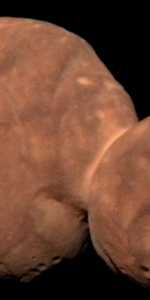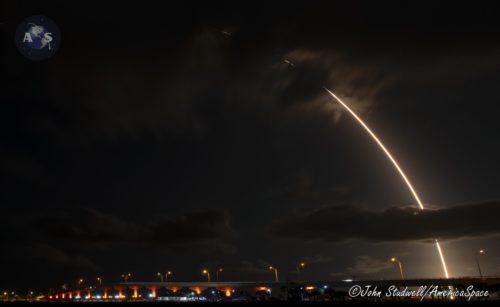
It was third time lucky for SpaceX’s first Starlink mission on Thursday, 23 May, which rose on-time from Space Launch Complex (SLC)-40 at exactly 10:30 p.m. EDT. Photo Credit: John Studwell/AmericaSpace
For the fourth time in 2019, SpaceX launched in the hours of darkness late Thursday, 23 May, to deliver its first 60 Starlink communications satellites into low-Earth orbit. Tipping the scales in excess of 30,000 pounds (13,620 kg)—the heaviest payload ever lofted by the Hawthorne, Calif.-headquartered launch services organization, according to CEO Elon Musk—the Upgraded Falcon 9 booster roared aloft from Space Launch Complex (SLC)-40 at Cape Canaveral Air Force Station, Fla., at 10:30 p.m. EDT. Launch occurred right on the opening of Thursday night’s 90-minute “window”, following a pair of 24-hours scrub last week, due to high winds at altitude and a need to update the Starlink software load.

Like a gigantic stack of cards, the Starlink payload proved a “tight fit” into the Upgraded Falcon 9 fairing, according to SpaceX CEO Elon Musk. Photo Credit: SpaceX/Twitter
Less than nine minutes later after launch, the previously-flown first-stage core—designated “B1049” and already a seasoned veteran of the September 2018 Telstar 18V geostationary mission and January 2019’s final launch for the Iridium NEXT low-orbiting mobile communications network—descended smoothly back to Earth and alighted on the deck of the Autonomous Spaceport Drone Ship (ASDS).
The drone ship, nicknamed “Of Course I Still Love You”, had initially departed Port Canaveral on late Saturday, 11 May, bound for a position some 385 miles (620 km) offshore. Remarkably, the customary Static Fire Test of the nine Merlin 1D+ first-stage engines was conducted at SLC-40 late Monday, 13 May, only two days ahead of Wednesday’s scheduled launch. This set a new testfire-to-opening-launch-attempt record of only two days; a substantially shorter interval than has been historically achieved.
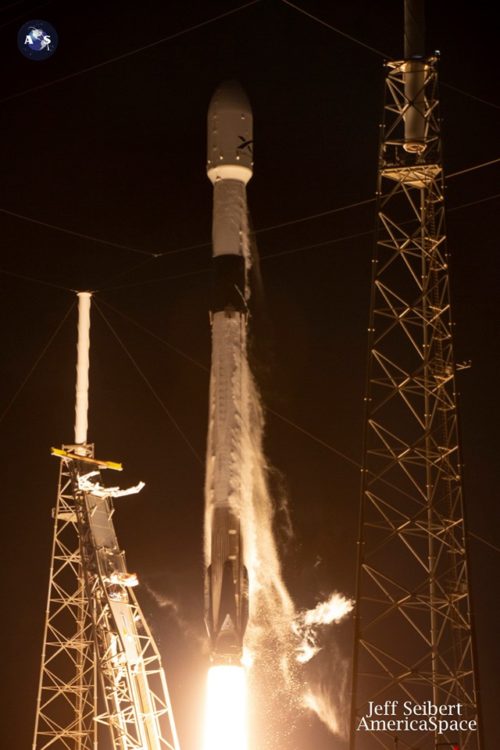
As outlined in AmericaSpace’s preview article, this mission represents the dawn of what SpaceX CEO Elon Musk envisions will revolutionize low-cost broadband internet provision and establish a much-needed financial base for ambitious SpaceX plans to eventually colonize Mars. The $10 billion Starlink effort was unveiled by Mr. Musk in January 2015 and in its current guise it is anticipated that around 12,000 satellites will be deposited into low-Earth orbit over the course of the next half-decade.
If successful, Starlink promises to boost data-speeds and increase the availability of internet access worldwide, including underserved and rural regions of the United States. Under the announced Starlink plans, the fully-deployed satellite network could have the bandwidth potential to carry up to half of all backhaul communications traffic and up to a tenth of all local internet traffic in high-population-density cities.
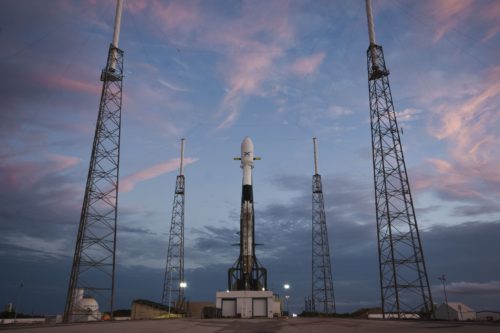
Its core stage blackened and scarred from two previous launches, B1049 has now secured three successful droneship landings in only eight months. Photo Credit: SpaceX/Twitter
The Starlink network operates in two portions of the electromagnetic spectrum; the Ku- and Ka-band, respectively at 12-18 GHz and 26.5-40 GHz, and the rarely-used V-band, which covers 40-75 GHz. Initial plans called for 4,425 satellites at an altitude of 710 miles (1,150 km) in the Ku-/Ka-band network and another 7,518 satellites at 210 miles (340 km) operating in the V-band. In February 2018, two Starlink precursor test payloads—dubbed “Tintin A” and “Tintin B”—were launched piggyback aboard an Upgraded Falcon 9 and last November SpaceX made new regulatory filings with the Federal Communications Commission (FCC) to operate almost a third of its Ku-/Ka-band fleet at a significantly lower altitude of just 340 miles (550 km). The FCC approved the filing in April.
Operating at such low altitude, of course, are expected to cause the Starlink birds to suffer from exceptionally high levels of atmospheric drag. SpaceX has previously indicated that the satellites’ useful lives will range from five to seven years apiece, after which they will be propulsively maneuvered, via their krypton-fed Hall electric thrusters, into “disposal” orbits for controlled re-entry within 12 months of ending their missions. In its official Starlink press kit, SpaceX highlighted the satellites’ “simplified design” and noted that each is equipped with a Startracker precision-pointing system and the capacity to track orbital debris and autonomously execute collision-avoidance. “Additionally,” the SpaceX preview notes indicated, “95 percent of all components of this design will quickly burn in Earth’s atmosphere at the end of each satellite’s lifecycle—exceeding all current safety standards—with future iterative designs moving to complete disintegration.”
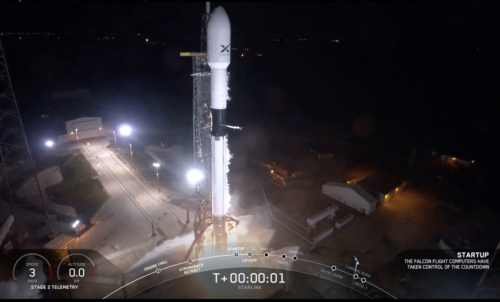
Liftoff occurred at 10:30 p.m. EDT, right on the opening of Thursday’s 90-minute “launch window”. Photo Credit: SpaceX
Earlier this month, after much speculation, Mr. Musk tweeted an image of the first Starlink payloads, fully stacked and ready for encapsulation within the Upgraded Falcon 9 nose shroud, and for the first time confirmed how many satellites would fly on this first mission. With 60 Starlinks riding uphill, tightly stacked together, and each satellite noted to weigh in the region of 500 pounds (227 kg), the overall payload mass of this mission can be totaled in excess of 30,000 pounds (13,620 kg). This fits comfortably within SpaceX’s published payload-mass envelope of 50,265 pounds (22,800 kg) to low-Earth orbit for the Upgraded Falcon 9.
Weather conditions for Wednesday’s opening launch attempt, and indeed Thursday’s backup opportunity—with an identical 90-minute “window”, running from 10:30 p.m. through midnight EDT—were predicted to be 80-percent favorable. In its L-1 briefing on Tuesday morning, the 45th Weather Squadron at Patrick Air Force Base noted the progress of a weak frontal boundary along the Space Coast and stressed an expectation that it would likely stall over Central Florida throughout Wednesday’s launch window. “The primary concern is any enhanced cumulus clouds moving onshore,” it was noted. “Maximum upper-level winds will be from the west at 110 knots near 45,000 feet.”
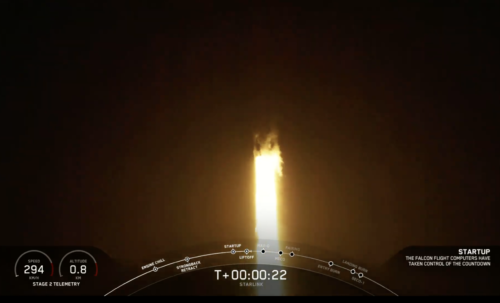
Thursday’s flight was the fourth night launch for SpaceX in 2019 and its sixth mission of the year overall. Photo Credit: SpaceX
Unfortunately, Wednesday, 16 May was not to be SpaceX’s day. High upper-level winds prompted a shift in the T-0 time to 11 p.m. EDT, before the attempt was scrubbed and the countdown clock recycled for the backup opportunity on Thursday night.
Conditions were expected to improve to 90-percent favorable. “Unusually dry air will continue to filter into the Spaceport Thursday as a surface front remains stalled over South Florida,” explained the 45th Weather Squadron in its Thurday morning briefing. “Favorable conditions are anticipated during the launch window with only a few cumulus clouds expected in light onshore flow.”

Sadly, a launch on Thursday, 16 May, also proved fruitless and the attempt was scrubbed. “Standing down to update satellite software and triple-check everything again,” SpaceX tweeted shortly after the closure of Thursday night’s window. “Always want to do everything we can on the ground to maximize mission success, next launch opportunity in about a week.” At length, a revised target to launch on Thursday, 23 May—again tracking a 90-minute “window” from 10:30 p.m. through midnight EDT—was set.
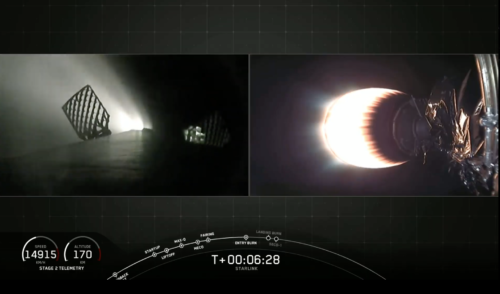
As the Merlin 1D+ Vacuum engine of the second stage flared to boost Starlink to orbit, the B1049 core returned smoothly back to Earth for a touchdown on the Autonomous Spaceport Drone Ship (ASDS). Photo Credit: SpaceX
Weather conditions were expected to be around 90-percent favorable for both the Thursday attempt and a backup option, secured on the Eastern Range, for Friday. “A very strong upper-level ridge remains over the Southeast U.S., keeping convection very isolated and limited mainly to shower activity along the Florida sea breezes,” the 45th Weather Squadron explained in its L-1 briefing on Wednesday, 22 May. “Temperatures will remain unseasonably warm across Central Florida, as this ridge pattern will persist for several days. The Space Coast will see isolated morning showers each day as the east coast sea breeze develops, then clearing by early afternoon as it pushes inland. Winds will increase Thursday as the surface ridge repositions, but should decrease after sunset. The primary concern is higher surface winds lingering into the evening.”
Loading of the sooty-looking Upgraded Falcon 9 first stage with liquid oxygen and a highly refined form of rocket-grade kerosene (known as “RP-1”) got underway at T-35 minutes. This was followed by the onset of second-stage cryogenic tanking at T-16 minutes.
Liftoff occurred on time at 10:30 p.m. EDT, kicking off SpaceX’s sixth mission of 2019 and its fourth night launch of the year. In scenes which have become increasingly familiar—but which never seem to lose their innate ability to thrill—the first stage burned for 2.5 minutes, before separating and commencing its powered descent back through the “sensible” atmosphere to alight on the ASDS.
And for B1049, it marked this particular core’s third successful droneship landing in just eight months. It joins only two other Block 5 cores—B1046 and B1048—in having logged as many as three flights. Of those, B1048 has two droneship landings and a ground-pad touchdown under its belt, whilst B1046 (the first Block 5 core to fly) has alighted on the ASDS on all three occasions.
Meanwhile, the single Merlin 1D+ Vacuum engine of the second stage burned for six minutes, then shut down for a half-hour coasting phase, ahead of a final firing to position its Starlink complement for deployment. At 62 minutes after liftoff, the five dozen satellites began the process of being released from the second stage at an initial orbital altitude of 275 miles (440 km). They then utilized their on-board Hall thrusters to raise themselves to their operating altitude to 340 miles (550 km).




